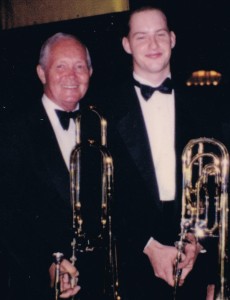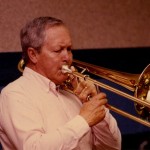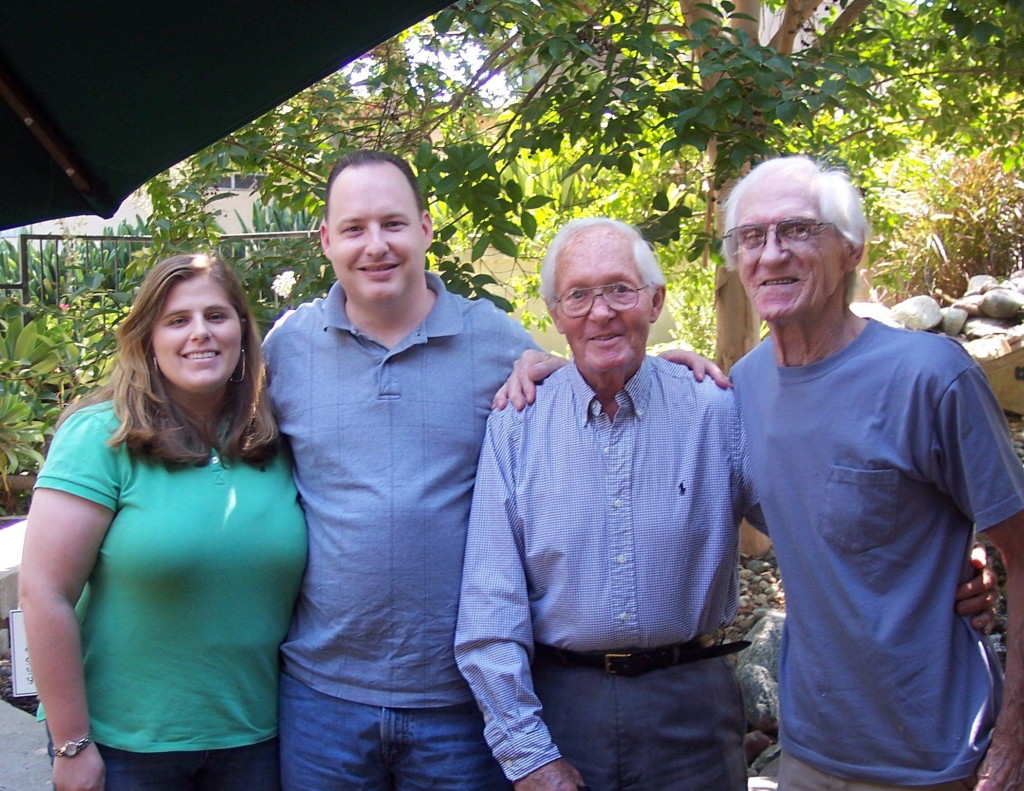With the passing of George Roberts, Mr. Bass Trombone, it seems as if That Rainy Day is here. For all of us who ever heard or met Roberts, the loss is tremendous, and our horns are a bit heavier now. According to Jim Self, tuba studio great, “George Roberts was a sweet man, great musician and friend. I got to sit next to him on hundreds of recording sessions and concerts. He liberated the bass trombone and made it a beautiful solo instrument. He’s on my list of musical heroes.” “Seven Positions” tm is saddened to note the passing of George Roberts, a man who occupies a place that is perhaps unique amongst virtuoso of any instrument: he is universally acclaimed to be the inspiration and model for all bass trombonists, classical and jazz. He will be missed.
What do you do when the world’s greatest bass trombonist retires to your community? Jon Yeager, who was an aspiring young high school aged bass trombonist did what came naturally; he took lessons. Yeager was to forge a long lasting friendship with George Roberts, “Mr. Bass Trombone”, that persisted as Yeager went away to University, eventually publishing an impressive dissertation on George Roberts, his life and approach to music. Roberts immense talent manifested itself during his retirement years as he innovated the bass trombone duo with pianist Reg Powell. Later, Roberts would go on to present the bass trombone in live performances with pre-recorded backing tracks from Powell and friends like the great arranger Nelson Riddle.
 How did you first meet George Roberts?
How did you first meet George Roberts?
George had just moved down to Fallbrook, California, and he did a clinic at my high school. I was a freshman, and I did not have any real concept of who he was or how important he was. However, he must have had a strong impact on me that afternoon, because I went home and asked my parents if I could begin taking trombone lessons, from him, of course.
How long did you study with him?
We did our mostly-weekly lessons until I graduated high school. I was very lucky-it turned out he lived about a half mile down the road, and we became pretty good friends. Of course, George has been friends with just about everybody he has ever met. On the weekends, George would play over his background tapes at various coffee shops. Eventually, I gave him rides down to Kaffee’s on Coronado Island, and he would let me play a couple of tunes each week. We continued doing that every time I came home from college.
What kind of concepts did he work on?
George really avoided getting too specific about technique. It was all about singing songs and telling stories. He showed me how to phrase songs and how to be free with rhythm. Along the way, he would throw things at me like slide vibrato and how to fake notes and simplify things. He also showed me head vibrato, which he used pretty regularly at the time, but I had trouble with it at the time.
Materials?
Materials were almost exclusively background tapes and lead sheets. Mostly, he would sit in our living room, I would play a tune for him, and he would comment and model for me, vocally. Occasionally, we listened to recordings by people like Urbie Green and Bill Watrous. Early on, he gave me a beginning tuba method book to work on my bass trombone playing. I think it was Best In Class, but I don’t think he ever listened to me play any of it.
What do you feel remains with you from his teachings?
Striving to be a master of the basics: sound, intonation, time, style.
Did he offer any insights into famous recordings or artists?
George and Nelson Riddle were friends, and Riddle called George one day. He told George he was trying to come up with some sort of Afro-Cuban type thing to incorporate into an arrangement he was working on. George sang him some of the opening of “23 Degrees North, 82 Degrees West”, which he had recorded with Kenton. After a few bars, Riddle told him that he thought he could do something with it, and he proceeded to write the trombone crescendo section in the middle of “I’ve Got You Under My Skin” for Sinatra.
What prompted you to do your research paper on George?
Strangely, it hadn’t really occurred to me to write my dissertation about George until Vern Kagarice at North Texas suggested it. After I thought about it, George and his style seemed like an obvious topic for several reasons: 1) George’s influence on the world of bass trombone has been profound; 2) no one had ever really formally analyzed his playing; 3) it was a topic I was interested in; and 4) I realized I was probably as qualified as anyone to do it.
I’m about to shoot myself in the foot, but now I question whether or not I should have written a formal paper about George’s playing. The good thing about it is that it is a tangible document that can serve to teach younger players about George’s importance and what was different about his playing. The downside is that reading a paper seems like a fairly clinical way to learn about George’s playing. The best way is to find recordings and just really listen to them. So instead of recommending people read my dissertation, I’ll point them to my website.
GeorgeRobertsTribute.com has a discography I spent a few years compiling, and there are some comments about George by several very well-known players. If people still want to read my paper, there’s a link to it there. Actually, the last part of my dissertation is the best part, and something that people may find of interest. It consists of transcripts of my two interviews with George, great stories and advice.
Who were his musical heroes?
George has mentioned trombonists such as Tommy Dorsey, Bill Harris, and Urbie Green, but I think he really idolizes Jack Teagarden and how Teagarden didn’t try to play like everyone else.
Being a vocalist the trombone, George often spoke of singers in our lessons. He referred to Sarah Vaughan, Nat Cole, Tony Bennett, and Ella Fitzgerald, but I think he had the greatest respect for Frank Sinatra and the way he interpreted songs.
What do you feel are the essential elements of his style?
George sings through his trombone, with a sound that projects “like a trombone.” He doesn’t try to play like a big, macho bass trombone, unless it’s really appropriate. Even in the low register, his playing shows his personality: beauty, lightness, sense of humor. He has told me many times that his idea was to play like Urbie Green, but an octave lower.
What techniques or ability allowed him to ‘get on tape’ so readily and easily?
That projecting sound. He tells a story about a recording session many years ago. I don’t remember all the details, but it was something like: someone asked the lead trombone player what he thought of the bass trombonist, and the lead player said, “I can barely hear him. He doesn’t play loud enough.” Then they went into the booth and listened to the take, and George’s sound just about dominated the section.
What do you remember about the horns he played?
He has developed instruments for Olds, Holton, Yamaha, Conn, and Kanstul, I think in that order. When I met him, he was working with Yamaha on the 612. My parents got one for me, and that’s what I’ve played for most of the last twenty-plus years. It’s a very light horn that speaks right away. Except for the Yamaha, I’m pretty sure his instruments have always been single-valve horns, because he doesn’t like the mass of a second valve section. I think he has always used a Remington lead pipe and 1 ½ G-style (maybe slightly oversized) mouthpiece-nothing too big.
What was it like to go to a coffee shop and hear George Roberts?
Those visits to the coffee shops are some of my fondest memories and when probably my most profound musical and personal instruction occurred. That’s not meant to take anything from some other great teachers I’ve been fortunate enough to have, but interacting with George and hearing him in person really inspired me as a trombonist and had an effect on the type of person I have become.
Why was he so important for the bass trombone?
He was the one who took the bass trombone from being basically a rare, heavy, background instrument in popular music to one that could be a versatile, expressive male voice. He’s the one that prompted arrangers to write interesting lines for bass trombone and proved that the bass trombone could be a beautiful solo instrument.
One of the things that you mentioned in our telephone conversation, was that George heard what he wanted before he played it.
I think George has a very clear mental image of the sound he wants, but much of what he does musically is spontaneous. Something else I should have mentioned was his emphasis on beginners establishing a great sound before learning a bunch of notes. He might say, “Learn to play the most beautiful sound in the world, then learn what to do with it.”
Interested in more “Seven Positions tm Interviews?
Charlie Vernon
James Markey
Chris Brubeck
Doug Yeo</a
Jeremy Morrow
Tom Everett
Gerry Pagano
Ben van Dijk
Randall Hawes
Denson Paul Pollard
Thomas Matta
Fred Sturm
Bill Reichenbach
Massimo Pirone
Erik Van Lier
Jennifer Wharton
Matyas Veer
Stefan Schulz
c. 2014 David William Brubeck All Rights Reserved. davidbrubeck.com
Images courtesy of Jon Yeager and David Brubeck



